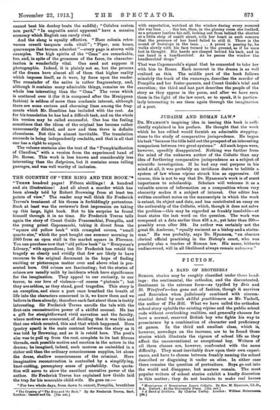THE COUNTRY OF "THE RING- AND THE BOOK."* "Tag hundred
pages! Fifteen shillings ! A hundred and six illustrations! And all about a murder which has been already told by Robert Browning from at least ten points of view." The reader may well think Sir Frederick Treves's treatment of his theme is forbiddingly portentous. Such at least was the reviewer's first impression on taking up this large, light book. But to his surprise he found himself through it in no time. Sir Frederick Treves tells again the story of Count Guido Franceschini, Pornpilia, and the young priest Caponsacchi, taking it direct from the "square old yellow book" with crumpled covers, "small quarto size," which the poet bought one summer morning in 1860 from an open stall in the market square in Florence. You can purchase now that "old yellow book" in " Everyman'a Library," with appendices; bat Sir Frederick has retold the tragedy so clearly and vividly that few are likely to have recourse to the original document in the hope of finding exciting or picturesque matter over and above what is pre- sented here. Old crimes are fascinating; but the stories of crimes are usually unlit by incidents which have significance for the imagination. They appeal to our curiosity, to our terror, to our love of violence—of course " platonic "; but they are seldom, as they stand, good tragedies. This story is an exception, and since a poet once breathed the breath of life into the characters concerned in it, we know them and we believe in them already; therefore each fact about them is trebly interesting. Sir Frederick Treves unrolls the tale with the first-rate reconstructive power of a skilful counsel. He has a gift for straightforward vivid narration and the faculty, where motives are concerned, of deciding that it was this and that one which counted, this and that which happened. Here (poetry apart) is the main contrast between the story as it was told by Browning, and as it is retold here. The poet's aim was to pull up from the root, complete to its last fibrous threads, each possible motive and emotion in the actors in the drama; he imagined, indeed, such motives as embedded in a richer soil than the ordinary consciousness supplies, let alone the dense, shallow consciousness of the criminal. Here imaginative reconstruction is controlled by a simplifying, knot-cutting, peremptory sense of probability. One quota- tion will serve to show the excellent narrative power of the author. Sir Frederick Treves has explained how Guido laid the trap for his miserable child-wife. He goes on :— "For two whole days, from dawn to sunset, Pompilia, breathless * The Country of "The 11;ng and the Bo)k." By Sir Frederick Troves, Bart. London: Cassell and Co. [13s. net.]
with expectation, watched at the window during every moment she was free. . . . See her, then, in the gloomy room she loathed, as a prisoner loathes his cell, looking out from behind the shutter at a little strip of sunlit street, with her heart in such concern that the pressure of her hand failed to still it. There is the sound of footsteps in the lane. . . . A priest is passing by, he walks slowly with his face turned to the ground, as if he were lost in thought. His hands are clasped behind his back, and in one hand is a handkerchief. As he passes the window the handkerchief drops."
That was Caponsacchi's signal that he consented to take her with him to Rome. Each moment in the drama is as well realized as this. The middle part of the book follows minutely the track of the runaways, describes the murder of Pompilia and her foster-parents, and Count Guido's trial and execution; the third and last part describes the people of the story as they appear in the poem, and after we have seen them in the light of the law court, so to speak, it is particu- larly interesting to see them again through the imagination of a poet.


















































 Previous page
Previous page